Harlan Meyer (1924 – 2013) and his company, Hi-E Engineering, represented the pinnacle of outside the box thinking, and genuine innovation, from the early 1970’s into the 1980’s. Based in Nashville, Tennessee, Harlan, a former aircraft engineer, applied principles learned through his work on aircraft, to bicycles. Hi-E came to existence because of Harlan’s son, John, a young lad racing bicycles in the early 1970’s. Bicycle technology at that time was primitive compared to what we take for granted in 2018. Harlan saw an opportunity to improve everything from components to frames and took it upon himself to design and manufacture innovative parts that were way ahead of their time.
The bike featured in this article is Harlan Meyer’s personal Hi-E Cosmopolitan, one of 15 such frames ever produced. Each one was unique in its own way, with differences in chainstays, forks and components fitted to these bikes. The first example was produced around January of 1971. Many of the design features you see in the Cosmopolitan are present in today’s road and gravel bikes. RIP Harlan Meyer, what an innovator!
First Flight Bicycles of Statesville, North Carolina, kindly allowed me to take these photos a couple of years ago. The shop currently plays host to MOMBAT (Museum of Mountain Bike Art & Technology), founded by Jeff Archer. Sadly, Jeff’s life was taken in 2016 by a drunk driver whilst crossing a street. The Hi-E collection and everything else within MOMBAT remain as a legacy to Jeff. Jeff was a true gentleman and opened the collection to me whenever I passed through town. Thank you Jeff.
The museum itself was a difficult environment in which to shoot photos, but I hope these photos do justice to this incredible bike.
Above, if you thought single chainring bikes (1x) were a new idea, think again. This crankset is circa early 1970’s. Don’t forget, this was from an era when front derailleurs were fitted to most road bikes.
Note the riveted aluminium construction of the frame, and the reverse horizontal dropouts, many years before Gary Klein’s distinctive dropouts.
Above, an integrated chain guard keeps everything in place on Harlan’s unique crankset. The crankset began life as an aluminium blank, with final machine work to bring it up to a decent level of production finish.
Harlan’s crankset also features a unique bottom bracket interface.
In the photo above, taken from one of three Hi-E Cosmopolitan frames / bikes in the MOMBAT collection, you can see the Cosmopolitan’s press-fit bottom bracket. This came from a time when 68mm English, 70mm Italian and French thread square taper bottom brackets were the norm. The press-fit technology was at least a decade or two ahead of its time.
Note also the spoon “brake” on this example. Little is known how it operated or how effective it was.
The particular crankset was of double braced construction and quite crude. But, every Hi-E crankset I have seen featured a removable spider, another item way ahead of its time and seen on many modern cranksets.
Integrated headset and internalized cables, on a bicycle circa early 1970’s!
Note the aluminium segmented fork.
The fork features further segmenting and riveting towards the bottom.
Hi-E was best known for its hubs and “slow-release” skewers, which feature on Harlan’s bike, along with his own rims.
Above, a bar end shift lever handled the chores of shifting, and was a precursor to the fully integrated brake and shifting systems of today. Note the locking mechanism for the headset, which whilst integrated (as in the bearings), still relied on the older quill stem interface. The various wires pictured are from an unknown bike computer.
Harlan’s personal Cosmopolitan was mostly unpainted, but one or two other examples of the bike that remain in circulation were painted and feature two chainrings.
Above, the seat tube / top tube / seat stay junction was a very crude affair. I’ve not had the chance to ride one of these amazing bikes, but I expect they creaked a wee bit.
Above, an unfinished Hi-E Cosmopolitan frame. Note the integrated headset and fork.
This headset and fork design are very reminiscent of Look’s original integrated headset design in their KG196 carbon bicycle, circa early 1990’s. Felt Bicycles later introduced a similar design, known as the Bayonette system. As for the additional tubing near the handlebars of the Hi-E Cosmopolitan, a prototype brake lever?
Sadly, these are all of the photos I have of the Hi-E Cosmopolitan bikes. I hope to return to MOMBAT the future for better and more comprehensive photos.
Thanks for reading!
JOM


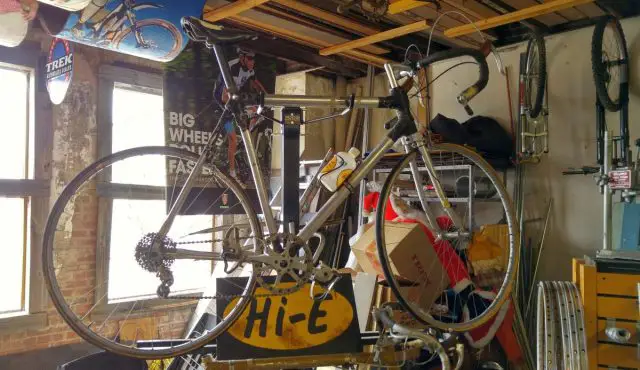
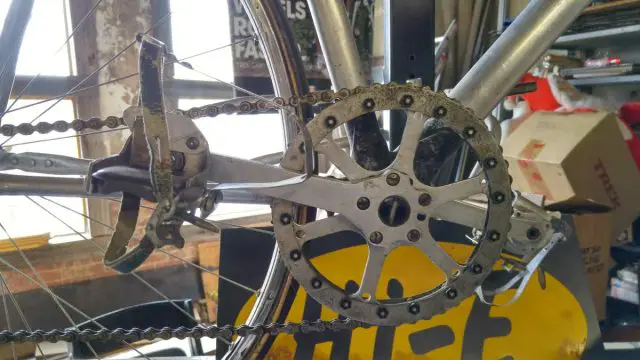
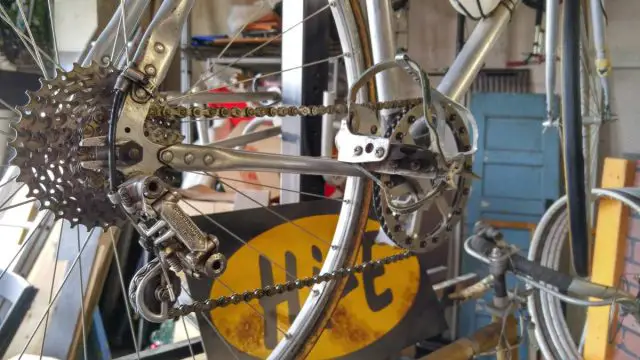
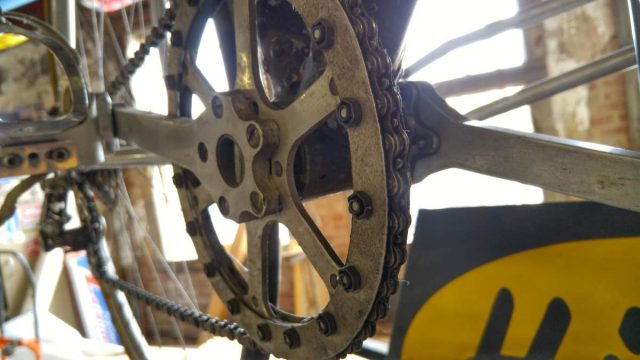
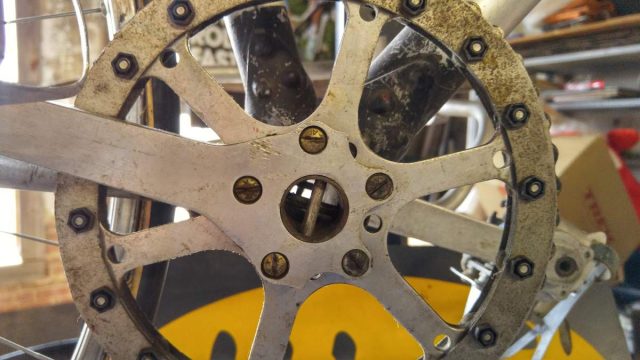
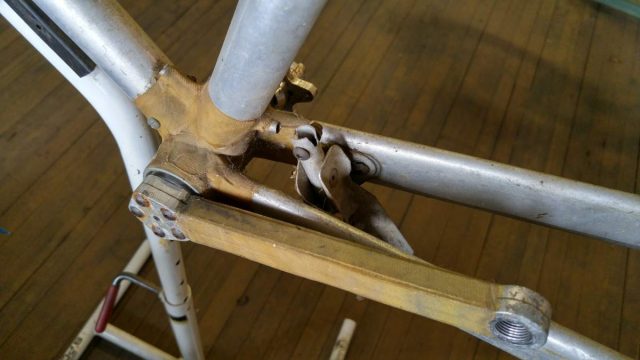
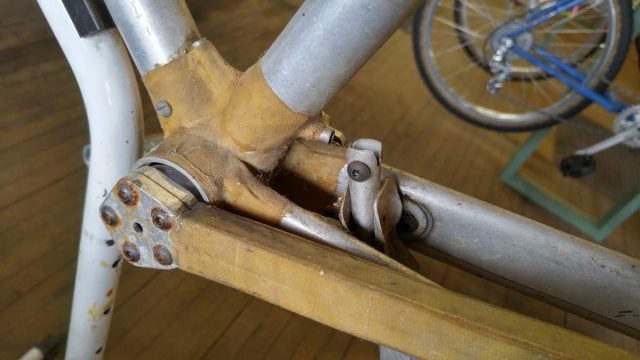
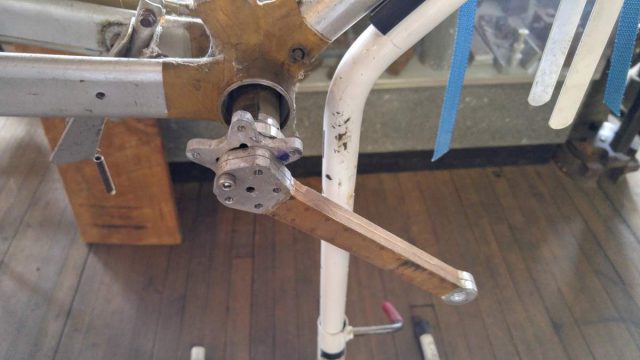
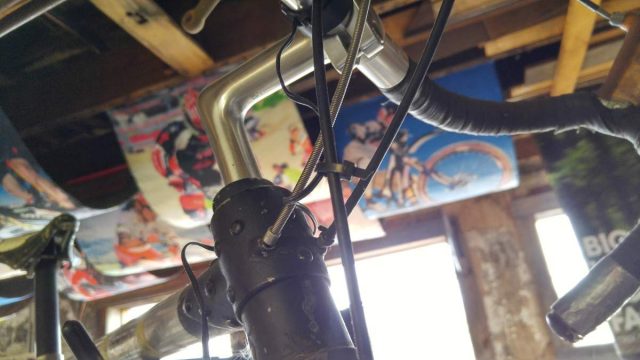
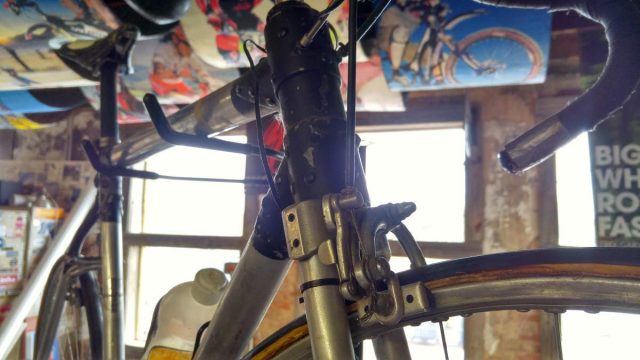
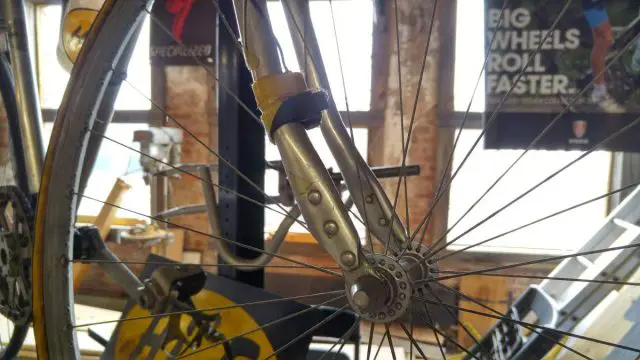
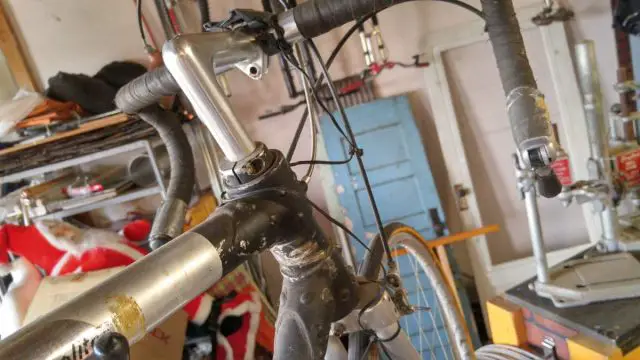
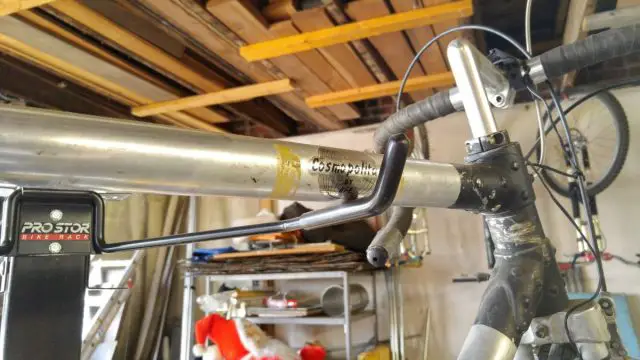
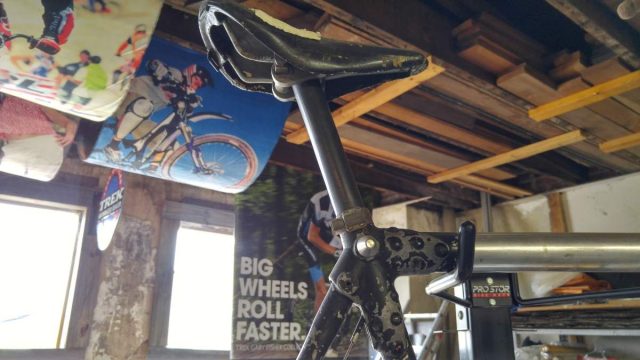
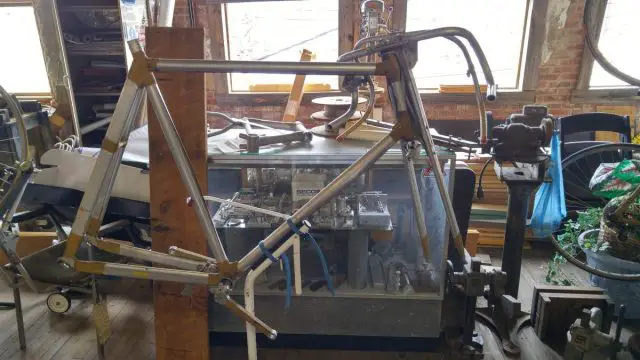
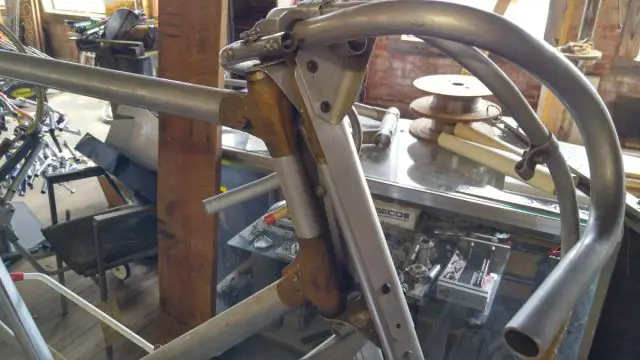
Nice write up of a very cool ride! Thanks
Thank you! I hope to take better, more detailed photos of the other Hi-E goodies at another time.
Thanks JOM — I’ve been around bikes a long time myself. The double diamond bike frame design has been around for over 100 years. Structurally and functionally, it is nearly perfect. Not much has changed really. Mostly the changes have been in improved material , and manufacturing technology, that has kept bikes affordable. I’m a fan of Jan Heine and BQ magazine. There were some awfully good bikes made before and after WW II.
I remember Hi-E Engineering from the early ‘70’s. Very innovative. I talked with Harlan in 1982. I wanted a set of hubs. He wanted me to buy Hi-E Engineering. Back then I was designing and building a very cutting-edge bike. I still have the bike today. It’s still the finest handling (and fastest) bike I have ever ridden. The hubs are the light model from Hi-E, 32 x 3x. Because of my system for building the wheels (off-the-shelf parts) they are true to this day and have not needed a spoke wrench put to them. The only other person I know of who has accomplished this is Pino Morroni however his method was much different and probably added at least an ounce to the wheels, and this was rotational weight and near the rim. Back then I also talked with Robert Barrett Side. His claim to fame was the RBS Side-by-Side tandem. Little known was his rear hub modification. He used a spline from the Phil Wood bottom bracket, and would machine your hub to be quick-release, but the freewheel stayed in the bike and the wheel only came out. (A-la Cinelli Bi Valent). Back then I also visited Walt Matthauser and I bought a set of his Matthauser “rolling bellowfram” hydraulic brakes. A design far ahead of their time. Of course the effite snobs at Elliot Bay Cycles (Davidson Cycles) hated them and were very snobbish. Can’t stand the place. R&E Cycles (Rodriguez & Erickson) were decent people, and very accommodating. Angel was very interested in my bike.
That was all many tears ago. Time has taken its toll and now I can’t remember why I placed this comment. I would be interested in buying a set of NOS Hi-E hubs if anyone has a set. Because I wanted my bike to be exotic, I paid tribute to Pino by including a set of his skewers on my bike. I may be able to send photos if anyone is interested.
-“Mad” Max Speedwell (cycles & engineering in no way related to Speedwell Gearcase Bicycles).
I had a set of Hi-E hubs that lasted for many 10’s of thousands of miles. They finally died when the hub flanges cracked and broke 20 years later. “Sealed” bearings that I never touched. They were like Phil Wood hubs but without all the polish.
I saw a lot of Hi-E hubs on Klein’s that came thru the shop I worked at in the 80’s. Very smooth and long lasting. At the shop I work at currently we had the pleasure of having one of Gary Klein’s personal bikes come thru on its way to Germany. I did not have a chance to take any photos, but it was still fairly light for its size, 18lbs.
Interesting stuff. You say the fork is aluminum, but what are the frame tubes? Aluminum or galvanized steel? And the bottom bracket connection is composite wrapped? As you say, cutting edge stuff for the time.
Frame tubes are all aluminium. I’m not sure what wrapping was on the unfinished frame, it didn’t appear to be a composite.
Very cool Jommie Mate, thanks for sharing!
Harlan Meyers ?
His name was Harlan MEYER ….NO ‘s’ ….NOT ‘Meyers’
Harlan also wrote a book on contract bridge bidding ….
I knew him personally and visited at his house a number of times
Thanks for the comment, although you don’t need to be so harsh about the error. Corrected.
Harlan was on that bike & told me about it at the KY Derby festival crit, the 1st bike race I ever saw (early 70s). John was a 19 yr old racing cat A (cat 1 today) as we had no Pro class at that time.
Hi, I have one of the 15 Cosmopolitan’s that Harlan built. I raced it in the northeast at critetiums due to its elevated cranks that allowed me to peddle in the turns. Also, have one of his custom truing stands and various other parts. My dad did cycling business with Harlan during the 70’s. I was wondering if anyone is interested in this stuff?
JOM, I wanted to commend you for writing such a great article. It is a wonderful tribute to Jeff Archer and Harlan Meyer. I was a member of the Music City Bicycle Club (Nashville) who Harlan sponsored. I travelled and raced with Harlan’s other son Jimmy Meyer. My uncle James “Jim” Mugler and my cousin Bobby Mugler were close friend’s of Harlan and they raced and many races using Harlan’s Hi-E wheel set’s.
Hi Paul, I really appreciate the kind words and hearing about your connection to Harlan. I wish I could have met Harlan, what an innovator. I had the pleasure of meeting Jeff on several occasions and he always opened up his shop to me, including the special stash, upstairs. An absolute gentleman and someone who is sorely missed by many in the cycling community.
Harlan was my dad’s cousin. They corresponded for decades about Harlan’s company (my dad helped small business owners sell their companies or find another company with which to merge). When my father died in 2004, I took over my dad’s correspondence (like my dad, I too am an engineer and could evaluate some of Harlan’s designs).
His ideas were indeed ahead of their time to the point that some of them seemed like crackpot ideas. Fortunately, by the time I started answering emails I had spent a decade helping fledgling technology businesses get off the ground, and I learned that the true innovators are so far ahead of everyone else that they almost inevitably come off as a crackpot.
I really enjoyed the article and am sorry I didn’t find it sooner.
Thanks for the confirmation!
I knew I wasn’t a crackpot😁
I would like to freely pass along my ideas to a much younger person(s) who is qualified to develop them.
Just an old dog who dreams of chasing sticks but in reality is too tired to wake-up and chase them. As for Gary Klein’s personal bike… I believe that was the one I rode in 1982. Light blue? My bike was similar to his. I juggled tube sizes, and wall thickness. Did a few changes with tires, fork, components….
-“Mad” Max Speedwell
Speedwell Cycle Engineering
(No affiliation with Speedwell Gearcase)
I visited the basement factory many times when I was 15 and won the Tour of Nashville in my division. Harlan sold me number 6, 17 lbs. complete. I had won the money in the Grants department store rock a thon. It boasted the most Hi E components of the 15 made. I rode thousands of miles on it.
Hello Lee, I assume you sold the bike?
Yes, I sold it in the early 80’s for $900 to a doctor up north.